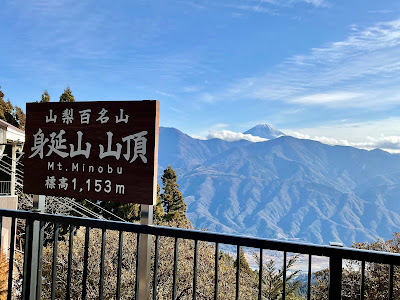This was a gorgeous day in late December and an amazing place to visit. There are a lot of pictures here, but these are a fraction of all the ones I took that day! Check out this website to find out all about this place. I've included some information from that site here, but if you are interested in this place, it would be best if you checked out the link.
I took two trains and a bus, then there was a lot of walking and a cable car and more walking.
The Sanmon Gate is considered the main gate to Kuonji Temple. It was first built in 1642 and has been rebuilt three times due to fire damage over the years. A major renovation was completed in 1907.
The massive gate stands 21 meters high and 23 meters wide. It is one of the three largest gates in Japan’s Kanto region.
Temple gates with three openings (Sanmon) are also referred to as gates of the “three liberations.” Each of the three openings in the gate represents one of these liberations: kumon (emptiness), musomon (formlessness), and muganmon (inaction). It is said that passing through the Sanmon Gate can rid the believer of the three human afflictions: greed, anger, and foolishness.
Bodaitei Stairway - 287 steps
Just beyond the Sanmon Gate is an ancient staircase built in 1652. The stairway is called the Bodaitei, which means “stairway to enlightenment.” It has 287 steps, and reaches a height of 104 meters.
In 1632, a Nichiren follower named Nizo arrived at Kuonji Temple with his mother. At the time, there was no staircase leading up the slope, so Nizo had to carry his elderly mother on his back to reach the temple. At the sanctuary, Nizo prayed for the means to build a stairway to make the pilgrimage easier for Nichiren devotees. It is said that Nizo was able to save enough money from his job as a fisherman and hoped to eventually return to Kuonji and build the Bodaitei. However, while on his way to Kuonji the second time, Nizo saw many people in Fujikawa suffering from famine. He believed that the lives of others, even strangers, were more important, so he gave them the money he had saved for the stairway.
Nizo returned to his home on Sado Island and went to work again to save money. After some time, he returned to Kuonji and erected a sign offering his hard-earned money for materials and labor to help build the Bodaitei. Soon, huge crowds of people gathered to help Nizo build the staircase, many grateful to be able to earn a small income and help contribute to the experience of visiting Kuonji.
At the top of the steps is the Five Storied Pagoda
This five-storied pagoda is one of the most distinctive landmarks on Mt. Minobu. It was originally built in 1619 and once stood on the east side of Kuonji Temple. It was built by Jufukuin (1570–1631), the mother of Maeda Toshitsune, third lord of the Kaga domain (in present-day Ishikawa prefecture). At the time, this pagoda was the second tallest in Japan. It unfortunately burned down twice, once in 1829 and again in 1875.
During the Heisei era (1989–2019), the process began to rebuild the pagoda once again. Architects hoped to accurately replicate its original form. By studying its ruins, they determined the dimensions of the original. They also studied other pagodas in Japan that were built by the same original architect. In 2009, it was completed, and is now the fourth tallest pagoda in Japan, at a height of 39 meters. It is made from the wood of 400-year-old trees felled from forests on Mt. Minobu and is painted with red iron-oxide paint.



































































































6 comments:
A great place. Thanks for taking all these photos and gathering information. You really ought to be a sightseeing planner!
Thanks for good explanations. I want to eat DANGO.
Another fantastic place to visit, the wooden buildings and bell towers are stunning. Always great to see Mt Fuji.
I can see why you took so many photos. It's really beautiful and I appreciate the explanations. The symbolism is so meaningful.
Your legs must have been sore after climbing so many stairs, but I bet it was worth it for the few!
It's a very famous temple. Although it is located in a neighboring prefecture, it can't be said that it is easily accessible. But it sounds like you went and did your own research and had a great time.
Just looking at it makes me feel like I can breathe in the clean air. Thank you for sharing so many beautiful photos.
I like the photo of big Pamela with long legs.😉
Post a Comment